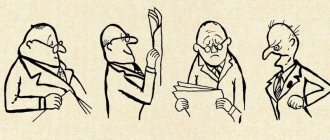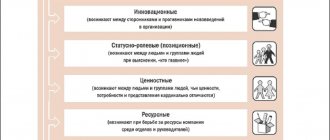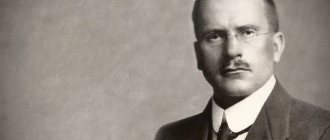Carl Gustav Jung is without a doubt an important name if we want to understand the history of psychology. His theories have been a source of both controversy and inspiration. It is not surprising that he is the founder of his own school of thought in the psychoanalytic field, the school of analytical psychology, also called complex and deep psychology.
For a long time, Jung was a student of Freud. However, he distanced himself from Freud mainly because he disagreed with his theory of sexuality. Moreover, Jung postulated the existence of a “collective unconscious” that precedes the individual unconscious.
“I know what I want: I have goals and opinions. Let me be myself, that's more than enough for me."
— Anne Frank
Jung was a restless intellectual who collected information from a variety of sources. In addition to neuroscience and psychoanalysis, Jung's theories were influenced by mythology, religion, and even parapsychology. One of his great interests was archeology, and this was probably his theory of archetypes. The theory of universal symbols present in the unconscious human mind.
Jung's personality type theory
For Carl Jung there are four basic psychological functions: thinking, believing, feeling and perceiving. In each person one or more of these functions have a special emphasis. For example, when someone is impulsive, according to Jung, it is because their “feeling and perceiving” functions take precedence over their “thinking and believing” functions.
Based on these four basic functions, Jung postulated that there are two basic character types: introvert and extrovert. Each has its own characteristics that distinguish it from the other.
Classification criteria
Jung's typology implies a psychological attitude according to which there are two types of people - extroverts and introverts. According to this teaching, the predominant mental functions are intuition, thinking, sensations, and feelings.
This typology was first presented in the work “Psychological Types,” written by Swiss psychiatrist Carl Gustave Jung in 1921. The purpose of the classification he developed was not to trivially divide people into separate groups according to any psychological characteristics. He wanted to create a special tool for a practical psychologist, with the help of which he could organize the accumulated psychological knowledge, study people, and reduce the number of errors in research.
Extroverted type
Their interests are focused on external reality, rather than on their inner world.
They make decisions by thinking about their impact on external reality, and not on their own existence.
Their actions are carried out in accordance with what others may think about them.
Their ethics and morality are built depending on what prevails in the world.
These are people who can fit into almost any environment, but they really have a hard time adapting.
They are suggestible, easily influenced and tend to imitate others. They need to be recognized by others.
Typology of characters according to K. Jung.
He was the first to develop the theory that every person has a psychological type. I am convinced that there are 2 classes of psychological “functions”: the first, through which we receive information, and the second, on the basis of which we make decisions. 8 psychological types have been identified. We get motivation from within ourselves (introverted) or from external sources (extroverted).
1. Extroverted feeling type. Characterized by impulsiveness, initiative, flexibility of behavior, and sociability. In reality, such people are not very intelligent at all.
2. Introverted feeling type. Characterized by a fixation of the individual's interests on the phenomena of his own inner world, unsociability, isolation, and a tendency to introspection. He can attract attention with his calmness, his passivity or reasonable self-control.
3. Extroverted intuitive type. He has a keen sense for everything that is emerging and has a future. Always on the lookout for new opportunities. He willingly takes on professions where he can develop his abilities in the most versatile way. More often among women than among men.
4. Introverted intuitive type. Characterized by the traits of a mystic-dreamer and seer, on the one hand, a dreamer and an artist, on the other. The dreamer is content with contemplation, which he allows to shape himself, that is, to determine himself. If he is an artist, then his art creates extraordinary things, things not of this world that shimmer with all colors, things that are beautiful and sublime. But if he is not an artist, then he often turns out to be an unrecognized genius.5. Extroverted thinking type. A person who has the desire to make the totality of his life manifestations dependent on intellectual conclusions. This type of thinking is productive. His thinking does not stagnate, much less regress.
6. Introverted thinking type. This type of thinking, like its parallel extraverted type, is influenced by ideas. He, like an extrovert, will follow his ideas, but only in the opposite direction - not outward, but inward. He strives to deepen, not expand. Even if he releases his thoughts into the light, he does not introduce them, like a caring mother of her children, but throws them up and gets angry if they do not make their way on their own. As clear as the internal structure of his thoughts is to him, it is equally unclear to him where and how they can be adapted to the world. His work is difficult. He is either silent or runs into people who do not understand him.
7. Extroverted feeling type. Pronounced sensual types are found among females. This kind of woman lives guided by her feelings. Thinking interferes with feeling. Therefore, thinking in this type is suppressed whenever possible.
8. Introverted feeling type. In most cases, they are silent, difficult to reach, incomprehensible, often hidden under a childish or banal mask, and often also have a melancholic temperament.
Jung introduced the concept of two types of personal orientation (extraversion and introversion)
And psychological functions (thinking and feeling are rational functions, sensations and intuition are irrational). From here Jung derived 8 personality types, combining orientation and function.
More details!!!
Extroverted type. “Extraversion is characterized by an interest in the external world and events, a desire to have friends and acquaintances without choosing them very carefully, a tendency to demonstrate oneself: his entire mental life plays out outside, directly, as a reaction to the environment. The earliest sign of extraversion in a child is his rapid adaptation to the environment, increased interest in objects, everything unknown and risky attracts him. The thoughts and behavior patterns of an extrovert are actually determined by external objective conditions, and inner life takes second place after external necessity.” The most common form of neurosis in the extroverted type is hysteria - this is a constant desire to make oneself interesting and draw attention to oneself, achieving one’s goal at any cost.
Introverted type. A distinctive feature of introversion is its focus on internal personal factors, on the inner world. Everything is based on one's own decisions, one's own thoughts and feelings, and this is more important to an introvert than other people and external circumstances. Such a person prefers to stay away from external events, does not like crowds of people, and communicates as needed. Introversion is just as normal as extroversion, although both are relatively normal. If an extrovert sees an introvert as asocial, selfish, unable to adapt to the real world, then the introvert condemns the extrovert as empty, devoid of inner depth. Early signs of introversion in a child are thoughtfulness, shyness, fear of unfamiliar objects, the child strives to do everything his own way, devalues things and other people.
Considering the issue of personality development, Jung emphasizes the movement towards self-realization through balancing and integrating various elements of personality. He used the term individuation to describe the lifelong process of unifying all aspects of the personality around the self. The process of individuation allows the self to become the center of personality, and this, in turn, helps a person achieve self-realization (few reach this level).
Ticket-8 Question 2 (42)
Neo-Freudianism and the reasons for its occurrence.
Neo-Freudianism is the development of social-cult aspects of psychoanalysis. Representatives: K. Horney, G. Stan Sullivan, E. Fromm. They reject Freud's pansexualism and emphasize the cult. and social the conditionality of neuroses, consider possible ways out of them by changing people’s attitudes. to yourself and other people.
K. Horney came to the conclusion that those appearances, cat. Freud associated with the biological, instinctive, and therefore universally human. manifestations are actually characteristic of a particular “culture, era, class and gender.” She also fundamentally disagrees with Freud's theory of female psychology. believes that we should abandon the structural division of the psyche into “it”, “I” and “super-ego” and theories formed on their basis. Instead of Freudian libido and aggressive inst. aspirations, she puts forward the “striving for security” and the “striving for satisfaction,” cat. I'm in. partly congenital, partly acquired, without specifying from which part. In some places she calls these aspirations “emotional.”
E. Fromm developed the problem of human happiness, the possibilities of achieving it, and gave an analysis of the two main ways of existence - possession and being. The central problem is the problem of ideal and reality in a person’s concrete life. According to Fromm, a person recognizes himself as a special being, separated from nature and other people, his physical. bodies and persons of the other sex., i.e., he is aware of his complete alienation and loneliness, which is the main problem of man. existence. As the only answer to problems, man. existence Fromm calls love as “the ultimate and real need of every human being.”
Harry Stack(n)Sullivan developed his own system and terminology. Nevertheless, his conceptual scheme repeats in general terms the reformed psychoanalysis of Horney and Fromm.
Wilhelm Reich placed the problem of sexuality at the center of his attention and recognized the need for complete sex. liberation of people by putting forward the idea of “sex. revolution." This meant the establishment of a truly human. (natural) relationships in love, work and knowledge.
Neo-Freudianism (from the Greek peos - new + Freudianism) is one of the influential trends in modern psychology, whose representatives in one way or another rely on Freud’s psychoanalysis.
Neo-Freudianism arose in the 20s and 30s. criticizing pansexualism and the ideas about the organization of mental life presented in orthodox psychoanalysis.
Its formation was influenced by the ideas of K. Jung and especially A. Adler, who emphasized the role of the influence of social conditions on the goal setting, the formation of a sense of community, and the occurrence of neurotic disorders. Neo-Freudianism recognizes the importance of anthropologists' discoveries about differences in the psychology of people belonging to different cultures. While maintaining the position on the determining role of unconscious processes and the ways they find for their expression, the theorists of neo-Freudianism try to overcome (or soften) Freud's biologism and focus on the importance of sociocultural conditions in the emergence of neuroses, explaining motivational forces and personality conflicts. Modern neo-Freudians adhere to a social orientation in their research, emphasizing the importance of social conditions, interpersonal and family relationships in the formation of a person’s personality. The largest representatives of neo-Freudianism are the American psychologists K. Horney (1885 - 1952), G. S. Sullivan (1892 - 1949), E. Fromm (1900 - 1980).
Neo-Freudianism in all its variants remains a theory of the unconscious; its supporters continue to consider the unconscious as the basis of human mental activity. The position on the social conditioning of the psyche is based on reducing the relationship between the individual and society to a conflict type.
In general, neo-Freudianism is characterized by such ideas about a person, his mental disorders and therapy, according to which treatment means the removal of obstacles that prevent one from living to the fullest and realizing one’s inner creative potential. From a neo-Freudian point of view, the ultimate goal of analytical therapy is to help a person regain his spontaneity, find values in himself, “give him the courage to be himself” and the ability to work
“in the direction of his self-realization” (Horney), to help him become productive, “interested in the world and responsive to its needs” (Fromm). The ideas of neo-Freudianism received support from some psychoanalysts and influenced the spread of humanistic attitudes in some countries, especially in the USA. At the same time, the neo-Freudian modification of classical psychoanalysis was criticized by those who saw in it the erasure of the differences between the theory and practice of psychoanalysis.
The ideas of neo-Freudianism, despite some limitations of their psychological concepts, had a huge influence on social life, ethics, culture and subsequently gave rise to many interesting branches and concepts.
Ticket-9 Question 2 (43)
Introverted character
On the other hand, the introvert type has the following traits:
They are interested in themselves, their feelings and thoughts.
They orient their behavior according to what they feel and think, even though this may be contrary to external reality.
They are not overly concerned about the impact their actions may have on their environment. They worry about everything that satisfies them internally.
They struggle to adapt to their environment and adapt to it. However, if they manage to adapt, they will do so in a creative and complete way.
Separation of functions
To specify the descriptions of the human psyche, a Swiss psychologist introduced two new terms - additional and auxiliary function. He made a division according to which he identified two groups:
- rational - thinking, feelings;
- irrational - intuition, sensations.
If any function begins to dominate, it will suppress the others. With the further development of the dominant functions, they are joined by additional ones that begin to accompany them, helping the base to strengthen.
Intuitive introvert
These people are extremely sensitive to the most subtle stimuli. Intuitive introverts are the type of people who can almost guess what others are thinking, feeling or wanting to do. They are creative, dreamers and idealists. They struggle with “keeping their feet on the ground.”
- 8 Physical Qualities That Reveal Your Personality
- 2 Personality Traits That Indicate You Have a High IQ
Definition of Temperament
In order to better understand who extroverts are and who introverts are, let's pay attention to the everyday definition of temperament and its difference from the scientific one. There is a general opinion that extroverts are such active, sociable guys who do not think, do not worry, and certainly do not tend to get upset over all sorts of trifles. Introversion was endowed with another worldly wisdom. These are sensitive, responsive, shy, timid and, without a doubt, vulnerable creatures. Such thinkers and philosophers of their time are always self-absorbed, abstracting from reality and closing themselves off from people. As often happens, the popular opinion about the definition of temperament does not fully correspond to the scientific approach.
Social typologies of personality
The peculiarities of personality formation are explained not only by psychology, but also by the influence of culture, history, and socio-economic living conditions.
Erich Fromm, a German-American psychologist, studied the issue of personality development since the end of the Middle Ages and came to the conclusion that isolation, loneliness, alienation are an integral part of human life, and that each historical period when humanity fought for its freedom and development, in its own way influenced the formation of behavior and attitudes.
Based on his observations, he identified five types of social character:
- Receptive orientation: people of this nature underestimate their potential and believe that they cannot be a source of anything good. They depend on the opinions of others, are not independent and constantly need approval and praise. The position of such a person is to be loved, not to love.
- Exploitative orientation: such people always look for their own benefit in everything. They achieve goals with strength and intelligence and are often ready to deceive and borrow other people's ideas for the sake of success.
- Acquisitive orientation: these individuals are very dependent on material goods, they are also called “hoarders”, because the more things they have, the calmer they feel. At the same time, they do not like to spend money, they constantly think about the past, and something new causes them fear.
- Market orientation: and here we are talking about the constant desire for financial success and the search for commercial gain. This is why people with a similar character establish any connections. Prestige and power are important to them; they clearly demonstrate their personal traits in order to look “more expensive” in the eyes of others.
- Fruitful orientation: this type of character, according to the scientist, is the ultimate goal in human development. Such people are calm, honest, independent, and prone to socially useful actions.
Erich Fromm divided these types of characters into fruitful (market and fruitful orientations) and unfruitful (receptive, acquisitive and exploitative orientations). Like other typologies, these types do not exist in a pure form, but are a combination of dominant and auxiliary character types [E, Fromm, 2006].
Eduard Spranger, a German philosopher of life, teacher, psychologist, in his book “Life Forms” identified six main personality types, each of which differs in perception of reality, values, motivation, etc. Here they are:
- Theoretical person: the highest form of activity for him is knowledge. It is important for him to be independent of specific goals; other values fade into the background.
- An economic person: it is important for him to benefit from everything to achieve his goals, so he saves resources.
- Aesthetic person: the highest value of the individual is harmony and aesthetics, the external world is assessed from the point of view of grace and suitability to the situation.
- A social person: love is the main principle of his life, and it must carry a religious meaning.
- Powerful person: Dominance over others is the dominant goal of the individual. He eschews any restrictions, and his boundless imagination helps to implement global projects that bring him fame.
- Religious person : focused on searching for the meaning of life and higher spiritual power [IP RAS, 2018].
Eduard Spranger believed that raising a child should be based on an understanding of what type of orientation he belongs to. Based on this, the teacher must instill in students certain life orientations.
So what was Hippocrates talking about?
According to the teachings of Hippocrates, temperament is a certain behavior of a person, which is associated with the predominance of a specific fluid in his body. He believed that the presence of mucus (lymph) in large quantities determines the degree of balance of a person, i.e. the more lymph, the calmer the person.
A high concentration of yellow bile makes a person impulsive, black bile - sad and melancholic, and blood - energetic. Based on these data, Hippocrates identified four types of temperament that explain human behavior:
- Sanguine temperament: One who has this type of temperament is characterized by activity and balance. This is a fascinating personality who willingly takes part in various events. She is characterized by a quick change of emotions, bright facial expressions and pantomime, and expressive laughter. Sanguine people have a high sensitivity threshold, so they do not react to distractions (sound, light). People of this type of temperament are distinguished by their efficiency and energy; they easily adapt to new conditions due to their flexibility and quickly switch attention from one thing to another. They are also distinguished by their speed of reaction, which is expressed in movements, speech, and love vivid impressions. These are typical extroverts. The dominant fluid is blood.
- Choleric temperament: choleric people are highly reactive, which is why they are often quick-tempered, impulsive, and unrestrained. Unlike sanguine people, such individuals are less flexible, therefore they strive to be stable in everything and have difficulty switching their attention. The dominant fluid is bile.
- Phlegmatic temperament: people of this type of temperament are active and balanced. There is little that can piss them off and force them to express their feelings. They are unemotional; it will be very difficult to make them laugh or cry. Phlegmatic people's facial expressions and gestures are monotonous and express practically nothing. They have difficulty adapting to new circumstances and shifting their attention. Such people live “within themselves”, it is difficult for them to make acquaintances, they do not like to be the center of attention, phlegmatic people are introverts. The dominant liquid is mucus.
- Melancholic temperament: melancholic people are characterized by low reactivity and high sensitivity. Such people are easy to offend; they can burst into tears even for a minor reason. They have inexpressive facial expressions, a quiet voice, and slow movements. Melancholic people get tired quickly. Such people are insecure and find it extremely difficult to adapt to a new environment, although in familiar circles they can be very sociable and tactful. As a rule, these are introverts. The dominant liquid is black bile [Yu. Aleksandrovsky, 2021].
Surely, reading the descriptions of each type of temperament, you found something similar to your character. It is almost impossible to meet, for example, a sanguine person or a choleric person in their pure form, because... Each personality is a combination of all four types of temperament.
Moreover, there is always one dominant type, and all the others complement it. If a person has all four types of temperament in approximately equal proportions, such a person is called a tetravert. To most accurately determine the type of temperament, it is enough to take the Hans Eysenck personality questionnaire or the Pavlovian temperament questionnaire (“Strelyau Questionnaire”).
Extroverts or active personalities
The extroverted personality type refers to people who love active action, power, universal respect, and try to show off. They try to occupy leadership positions and appear in public more often. Extroverts have no problems with communication. They love new acquaintances and big companies.
There are several typical character traits that can help identify an extrovert:
- adaptation to any team;
- desire to receive praise for good deeds;
- need for constant attention from others;
- intense gestures when speaking;
- lack of fear of difficulties;
- constant search for new things to do and activities;
- restlessness.
It cannot be said that extroverts constantly behave restlessly, restlessly, and aggressively. They can be embarrassed, show pity, be calm, and reasonable.
Jung argued that there are no 100% extroverts or introverts. More often, people combine different traits from the two types, combining them together
Who uses Carl Jung's test and why?
Practicing psychologists use this technique to establish the characteristics of a person’s personality. Social educators conduct this test among high school students in order, based on the type of their temperament, to help them socialize, discover their abilities and talents, and subsequently find their place in society.
Summarize
Each personality combines unique patterns of behavior, ways of perceiving the world, and a certain reaction to events. Among us there are no “pure” representatives of a certain typology; we combine various character traits that were given to us from birth or acquired in the process of life.
It’s amazing how carefully the ancient knowledge about human personality types is passed on from generation to generation to this day, despite constant changes in the outside world. They help us understand ourselves, our strengths and weaknesses, opportunities and prospects, and a detailed study of a specific personality type helps us understand the intricacies of communication, methods of persuasion, and even methods of resolving conflicts.
Knowledge of personality typologies and the ability to correctly evaluate people radically change the picture of the world: now what previously seemed strange is perceived as nothing more than a property of a certain human psychotype. Today you don’t need to be a born psychologist and know all the characteristics of personality typologies by heart; just take several online tests to determine your psychotype, and you will receive a detailed description of your “I” and recommendations.
We wish you good luck and suggest answering the question on the topic of the article:
Sensing extroverts
Such a person perceives the world around him through his senses. These people have one distinctive feature - they notice every little thing, but when communicating with them, you get the feeling that this is a soulless type of person. A simple situation - a conversation with a carpenter who is absorbed in the nuances of his work, talks only about it, and is reluctant to talk about other topics.
Such people are suspicious of everything that cannot be felt, touched, smelled, or seen. Sometimes they become crude pleasure seekers who do not recognize the spiritual side of man.
Thinking extroverts
These are ruling subjects who often make important decisions that affect those around them. They create their own schemes of objective reality, which guide them when making decisions. At the same time, they demand that others accept their worldview. When such people begin to create patterns based on deep analysis of consciousness, they become innovators for others.
Features of this type of personality:
- The slogan is - the end justifies the means.
- Constant service to the ideal.
- Friendship has no value.
They are rarely interested in art and do not show sympathy.
Differences between Freud's psychoanalysis and Jung's analytical psychology
How did Freud's views differ from Jung's? Let's highlight some differences.
1. The main differences between the analytical psychology of Carl Jung and Freudian psychoanalysis concern the question of the nature of libido . If Freud characterizes libido primarily in terms of the sexual sphere, then for Jung libido is vital energy in general, in which sexual activity is present only as one of the components and manifests itself in growth and reproduction, as well as in other activities that are most important for a particular person.
2. Also, Jung rejected the Freudian concept of the Oedipus complex . He explained the child's attachment to his mother by the purely everyday needs of the child, and the mother's ability to satisfy them.
As the child grows, he develops sexual needs that superimpose on the previously dominant needs for food. Jung suggested that libidinal energy takes on heterosexual forms only during puberty. He did not completely deny the presence of sexual forces in childhood, but he reduced sexuality to the position of only one of many drives in the psyche.
3. From Freud's point of view, a person is a product of his childhood experiences. For Jung, a person is determined not only by the past, but equally by his goals, expectations and hopes for the future. In his opinion, personality formation is not completed at the age of five. A person can change, sometimes quite significantly, throughout his life.
According to K. Jung, self-actualization can only be achieved in middle age, and therefore Jung considered this age (35-40 years) as a critical period for personal development - a boundary at which a person undergoes deep and beneficial transformations. Thus, for Jung, the most important stage of personal development is not childhood, as with Freud, but, on the contrary, adulthood, the time when he himself went through a mental crisis and was able to overcome it.
4. Another difference between Freud's and Jung's positions is that Jung attempted to penetrate deeper into the unconscious than Freud did. He added another dimension to the understanding of the unconscious: the innate experience of humanity as a species inherited from its animal ancestors (i.e., the collective unconscious).
Archetypes
Archetypes are innate tendencies within the collective unconscious that are the internal determinants of a person's mental life.
They direct human actions in a certain direction, somewhat similar to the way our animal ancestors behaved in similar situations. Archetypes reveal themselves in consciousness in the form of emotions and some other mental phenomena. They are usually associated with such important moments of life experience as birth and death, the main stages of the life path (childhood, adolescence), as well as with the reaction to mortal danger.
Jung explored the mythology and artistic creativity of a number of ancient civilizations, identifying the underlying archetypal symbols. It turned out that there are a significant number of such symbols that are inherent in all archaic cultures, even those that were so separated in time and space that direct contact between them was obviously impossible. He also managed to discover in the dreams of patients what he considered traces of similar symbols. This further strengthened Jung's commitment to the idea of the collective unconscious.
Four such archetypes are more common than others - Persona, Anima and Animus, Shadow, Self.
1. Anime and Animus archetypes are two components of one whole. They reflect Jung's assumption that each person carries within himself certain psychological characteristics of the opposite sex.
Anima reflects female unconscious (feminine) characteristics in a male character, and animus reflects male unconscious (masculine) characteristics in a female character.
Like most other archetypes, this pair originates in the deepest, most primitive layers of human ancestral experience, when men and women internalized certain emotional and behavioral tendencies of the opposite sex. Thus, every person has feelings, emotions and experiences of both sexes.
These archetypes not only cause each sex to have traits of the opposite; they also act as collective images that motivate each gender to understand and respond to the other.
2. The Persona archetype (Mask) is the mask that each of us puts on when communicating with other people. It includes our social roles and individual style of expression.
A persona represents us as we want to be perceived by society. It may not coincide with the individual's true personality. Jung's concept of Persona is similar to the concept of role behavior in sociology, when we act as we think people expect us to act in certain situations.
A person has both positive and negative aspects. The Dominant Persona can suppress, even stifle, individuality. Those who identify with their Persona begin to see themselves only in terms of their superficial social roles or façade. C. Jung also called the Persona the archetype of conformity. At the same time, the Persona is not only negative, it protects the Ego and the soul as a whole from various social forces and attacks aimed at it.
3. The Shadow archetype is the center of the personal unconscious, a focus for material that has been repressed from consciousness; this is a kind of reverse, dark side of the Self. It is most deeply rooted in man’s animal past. Jung considered it a kind of legacy of lower forms of life.
It includes tendencies, desires, memories, experiences that are denied by the individual as incompatible with his Persona or contrary to social standards and ideals.
The shadow represents the totality of all our immoral, violent, passionate and completely unacceptable desires and actions. Jung wrote that the shadow pushes us to do something that we would never allow ourselves to do in a normal state. When something like this happens to us, we tend to explain what happened by saying that something came over us. This “something” is the shadow, the most primitive part of our nature.
However, the shadow also has its positive side. It is a source of spontaneity, creative impulse, sudden insights and deep emotions, without which a normal, full-fledged human life is also impossible.
4. Archetype Self is the center of personality around which all other systems are grouped. It holds these systems together and provides the individual with unity, balance and stability. This is the central archetype of personality integrity, which integrates the conscious and unconscious in the human psyche.
The Self is both a true subject and an integral personality, and the goal of a person’s life, which he constantly strives for, but which he rarely achieves. Before the self can be embodied, the various components of the personality must undergo full development and individuation. According to K. Jung, a person can achieve balance only as a result of a long process of psychological maturation, which he calls individualization.









